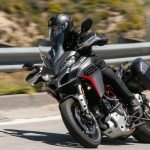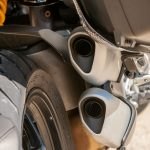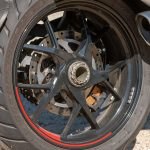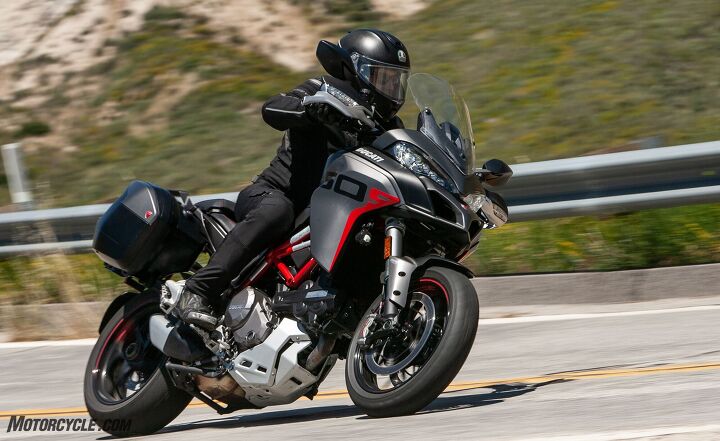| Engine | 18.5/20 |
| Suspension/Handling | 14.0/15 |
| Transmission/Clutch | 9.5/10 |
| Brakes | 9.25/10 |
| Instruments/Controls | 4.5/5 |
| Ergonomics/Comfort | 9.0/10 |
| Appearance/Quality | 9.5/10 |
| Desirability | 9.0/10 |
| Value | 8.0/10 |
| Overall Score | 91.25/100 |
I’ve ridden touring bikes all across the American continent. From a transcontinental dash on a touring cruiser to multi-day jaunts on Gold Wings to a gravel road to the Arctic Ocean in Prudhoe Bay, AK, I’ve done my time and racked up the miles, but none of the touring motorcycles I’ve ridden appeal to me as much as the sport adventure touring class of motorcycles. They appeal to me and the type of riding that I like to do. With that said, the 2020 Ducati Multistrada 1260 S Grand Tour is a great example of the species.
2018 Ducati Multistrada 1260 First Ride Review
What you get with the Multistrada 1260 S Grand Tour is all of the features of the S model (most notably the semi-active Ducati Skyhook Suspension (DSS) Evo, which allows easy adjustment of suspension baseline parameters) and adds a list of trim and comfort features. First, the Grand Tour gets an exclusive colorway of Sandstone Grey with a 1260 graphic on the fairing combined with a red frame and red highlights on the cast aluminum five-spoke wheels. The GT’s touring chops are augmented by standard hard bags and a centerstand. The rider and passenger seats feature Grand Tour logos. Premium electronic features include heated grips, tire pressure monitoring system, and keyless starting and fuel tank access. Dual LED spotlights increase conspicuity and nighttime visibility.
Other than all of the above listed items, the Grand Tour is all Multistrada 1260 S, and that’s a good thing. The Testastretta 1262cc DVT (Desmodromic Variable Timing) is an engine seemingly without weak points. First, the DVT massages the bottom end torque for more grunt down low, claiming 85% of the engine’s torque is available at 3,500 rpm – a fact that was confirmed by our trip to the MotoGP Werks dyno. With a peak of 89 lb-ft of torque hitting at 7,800 rpm, the 73 lb-ft we recorded makes for 83%. At higher rpm, the valve timing changes to benefit the increased volume of combustibles that need to be moved into and out of the twin cylinders. The 1260 engine hits its 143.5 hp peak at 9,800 rpm. That’s plenty to motivate a claimed 525-lb package.

Look at how flat and broad that torque curve is. While you can’t always run the engine out to its rev limit, you can have tons of fun in the mid-range.
The engine niceties don’t stop with the power output. The Grand Tour has a valve adjustment interval of 18,000 miles, which is a reasonable distance for a touring bike. The fueling is spot on with nary a hiccup during our test – and I tried to find some abruptness. Additionally, the Ducati Quick Shifter (DQS) handled every situation I tossed at it. From trolling around at low speeds to ripping off high-rpm shifts, I almost never used the clutch after getting the bike rolling.
As with all premium modern motorcycles, the Multistrada comes with a suite of electronic aids to help the rider keep the shiny side up. The IMU allows for fine-tuning of the Ducati Wheelie Control and Traction Control through eight levels plus off. Similarly, the Bosch IMU powers the Multistrada’s Cornering ABS and its Electronic Combined Braking System, which links the front and rear brakes in Urban and Touring ride modes and cedes most of its control to the rider in Sport mode. Designed to limit the rear wheel lift effect introduced by the high center-of-gravity and the long stroke of the suspension, the Electronic Combined Braking System can also be varied over a range of adjustments.

The 17-inch cast wheels point to the Grand Tour’s street focus, but the Pirelli Scorpion Trail IIs will get you down a dirt road or two without drama.
Braking is handled by a pair of 330mm discs squeezed by Brembo M50 calipers. I’ve loved these calipers for so long that I feel guilty for wishing they were Stylemas even though I know they aren’t necessary. Such are the fickle desires of a motojournalist. The master cylinder is a Brembo radial unit with an adjustable lever. Combined, they deliver formidable braking power that is more than capable of stopping the 1260 S with the immediacy that is desired from a sporty adventure tourer.
Riding the Grand Tour highlights how well Ducati balanced the needs of long-distance touring riders and sport touring riders. The rider triangle is just about perfect for an all-day horizon chase. Yet, although the seat does tend to lock you into one position, you can lean into a more attack-focused attitude when the road starts to squirm on the map. The handlebar width plays a major role in the bike’s flickability and its willingness to charge into a series of corners with an ease that belies its 525-lb. claimed weight. The Multi feels much shorter than its 62.4-inch wheelbase would imply. In my street-focused ride time with the Grand Tour, the Pirelli Scorpion Trail II tires performed a great impression of sport touring tires, but since my travels typically don’t take me onto any fire roads, I’d swap them for some more dedicated sport touring rubber when these tires were done.
The suspension, with its relation to the riding mode and therefore its ability to be adjusted on the fly, can play a vital role on traversing different kinds of pavement. I spent the bulk of my time in Sport and Touring modes since Urban mode limits the peak horsepower (and who wants that?). Basically, if I wasn’t attacking a winding road, I stuck to Touring. The throttle inputs are softened slightly, and the suspension is more supple for soaking up the broken pavement that you find in many urban centers these days. Interestingly, I also stuck with Touring on bumpy canyon roads. Yes, the softer settings allowed for more chassis pitch during braking and acceleration, but the softer settings do such a great job of soaking up the bumps, making for more pleasant work of those bumpy sections. When it’s over, a couple of clicks of my left thumb and a closing of the throttle has me back in Sport mode.
When the road straightens out and the rider wants to focus on racking up miles, the touring amenities come into play. As with all Multistradas, there is cruise control. The weather protection provided by the windshield is a good compromise between cooling and still air, but in its lowest position, turbulent air flows straight across the base of my helmet, raising the noise level. On cool days, the heated grips will be appreciated, and if you’re the forgetful type who frequently puts on their gloves before putting the key in the ignition, the wireless key fob is a godsend. You’ll still need to take the key out every time you want to open the saddlebags, though.
Rider comfort, though very good overall, takes two big hits with the Grand Tour. First, the seat tends to lock the rider into one position. While the position is quite comfortable, being able to move around on the seat would allow for more leg stretching. If you’re the type of rider who likes to ride with the balls of your feet on the pegs, you might have some issues here. On the right side, as is common on far too many Ducatis, the rider’s heel hits the muffler’s heat shield. On the left, the tang for the centerstand hits the other heel. I commend Ducati for fitting the Grand Tour with a centerstand – and one that doesn’t touch down easily in a corner – having it crowd the rider’s foot is a bit of a bummer. Riders who place the arches of their feet on the pegs will not be bothered by these issues, but their toe sliders might protest a bit.
Our time, though short, with the 2020 Ducati Multistrada 1260 S Grand Tour reminded us of how much fun the biggest Multistrada is for travel and plotting the shortest distance through a series of corners. The additional features that the Grand Tour package gives over the 1260 S is worth the premium, given how it augments the Multistrada’s touring capabilities. The 2020 Ducati Multistrada 1260 S Grand Tour is available now for an MSRP of $23,295.
| 2020 Ducati Multistrada 1260 S Grand Tour | |
+ Highs
|
– Sighs
|
|
In Gear
|
| 2020 Ducati Multistrada 1260 S Grand Tour Specifications | |
|---|---|
| Engine Type | Ducati Testastretta DVT with Desmodromic Variable Timing, L-Twin cylinder, 4 valves per cylinder, Dual Spark, liquid-cooled |
| Displacement | 1,262 cc |
| Bore x Stroke | 106 x 71.5 mm |
| Compression Ratio | 13.1:1 |
| Transmission | 6 gears |
| Fuel System | Bosch electronic fuel injection system, elliptical throttle bodies with Ride-by-Wire, equivalent diameter 56 mm |
| Final Drive | Chain |
| Clutch | Light action, wet, multiplate clutch with hydraulic control. Self-servo action on drive, slipper action on over-run |
| Ignition / Engine Management | Bosch EMS with RBW |
| Frame | Tubular steel Trellis frame |
| Front Suspension | Sachs 48 mm fully adjustable usd forks. Electronic compression and rebound damping adjustment with Ducati Skyhook Suspension Evo (DSS) |
| Rear Suspension | Fully adjustable Sachs unit. Electronic compression and rebound damping adjustment. Electronic spring pre-load adjustment with Ducati Skyhook Suspension (DSS) Evo. Aluminum single-sided swingarm |
| Front Brake | 2 x 330 mm semi-floating discs, radially mounted Brembo monobloc Evo M50 4-piston callipers, 2-pad, radial pump with cornering ABS as standard equipment |
| Rear Brake | 265 mm disc, 2-piston floating calliper, with cornering ABS as standard equipment |
| Front Wheel | 5-spoke Y-shape cast light alloy 3.50″ x 17″ |
| Rear Wheel | 5-spoke Y-shaped cast light alloy 6.00″ x 17″ |
| Front Tire | Pirelli Scorpion Trail II 120/70 R17 |
| Rear Tire | Pirelli Scorpion Trail II 190/55 R17 |
| Silencer | Stainless steel muffler with catalytic converter and 2 lambda probes, aluminum tail pipes |
| Rake / Trail | 25° / 4.37 in. |
| Wheelbase | 62.4 in. |
| Seat Height | 32.5 – 33.3 in. |
| Fuel Capacity | 5.3 gallons |
| Dry Weight | 525 pounds (claimed) |















The post 2020 Ducati Multistrada 1260 S Grand Tour Review appeared first on Motorcycle.com.
【Top 10 Malaysia & Singapore Most Beautiful Girls】Have you follow?



